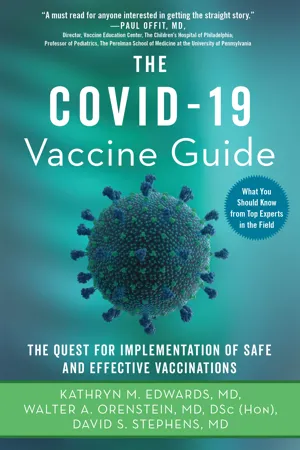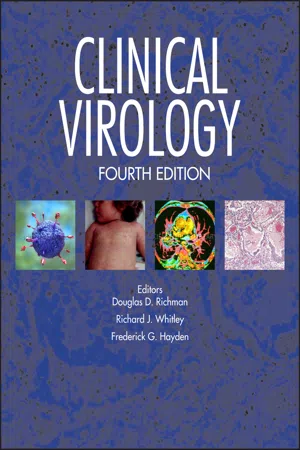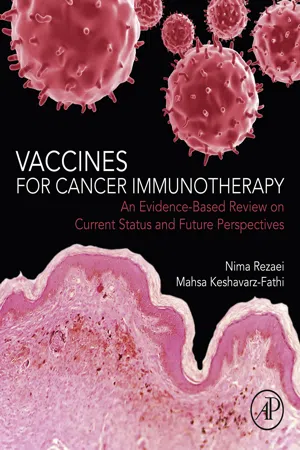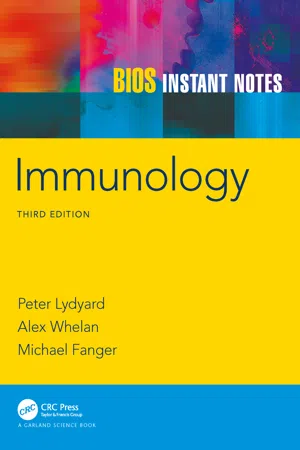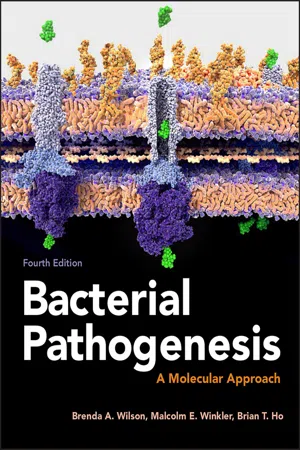Biological Sciences
Vaccines
Vaccines are biological preparations that provide immunity to specific diseases. They work by stimulating the immune system to recognize and fight off pathogens, such as viruses or bacteria, without causing the disease itself. Vaccines have been instrumental in preventing the spread of infectious diseases and have significantly reduced the global burden of illness and death.
Written by Perlego with AI-assistance
Related key terms
10 Key excerpts on "Vaccines"
- eBook - ePub
The Covid-19 Vaccine Guide
The Quest for Implementation of Safe and Effective Vaccinations
- Kathryn M. Edwards, Walter A. Orenstein, David S. Stephens(Authors)
- 2021(Publication Date)
- Skyhorse(Publisher)
Chapter 2 Introduction to Vaccines and VaccinologyV accines are the most cost-effective intervention for preventing human disease. What is a vaccine? How does it work? How do Vaccines protect?A vaccine is a substance, such as an inactivated protein from an infectious organism, that when given to a person induces an active immune response to prevent or mitigate a disease. Your immune system acts as an army. The immune system ideally detects the foreign invading germ (i.e., virus, bacterium, fungus), generally called a “pathogen,” and destroys it or contains it so that it cannot cause disease. What a vaccine does is give the immune system practice so that when it encounters the real pathogen, it is ready. Without practice from the vaccine, the pathogen can overwhelm an unprepared immune system, causing serious illness.The immune system can protect against infection and disease in two different ways. First, it can secrete immune proteins, called antibodies, into blood or tissues that bind to the invading pathogen and prevent it from multiplying or invading cells of the human body and enhancing the uptake of the pathogens into special cells (“phagocytes”) which destroy the pathogen. This aspect of the immune system is often called the humoral immune system. Critical players in this response are B cells and specialized B cells called plasma cells. The plasma cells produce the antibodies that circulate in the blood and other body fluids and tissues, which when encountering the pathogen neutralize it or bind to it, facilitating destruction of the pathogen by other cells of the immune system.Second, the immune system consists of specialized cells, called T cells, which destroy infected human cells and prevent the pathogen from spreading and causing serious disease. This aspect of the immune system is called the cellular immune system.A number of Vaccines include substances called adjuvants or immune system helpers. These adjuvants enhance the immune response to the vaccine. In the United States, the most common adjuvants are aluminum-based compounds. But an increasing number of Vaccines have other new adjuvants that stimulate immunity, particularly in the elderly or those with less-robust immune responses (see https://www.cdc.gov/Vaccinesafety/concerns/adjuvants.html - eBook - ePub
- Mariusz Skwarczynski, Istvan Toth(Authors)
- 2016(Publication Date)
- Elsevier(Publisher)
6To understand the principle of vaccination, it is important to comprehend how the immune system works. Vaccines, which contain a killed, weakened form or a subunit of a pathogen, aim to prime the immune system to respond to an infection by establishing memory cells without themselves inducing symptoms of disease. This enables a faster immune response upon reexposure to the pathogen in the early stage of infection and can result in herd immunity. Once a vaccine is administered and upon contact with antigen, cells in the surrounding tissues are activated to release proteins (ie, chemokines and cytokines) that attract leukocytes to the site of injury, in most cases leading to the uptake and processing of the antigen within antigen-presenting cells (APCs).7 This local accumulation of innate immune cells combined with their release of bioactive molecules (chemokines and cytokines) contributes significantly to the inflammation frequently observed in the form of redness and swelling at the injection site.8 , 9 Following initial infection, APCs [ie, macrophages and dendritic cells (DCs)]10 efficiently phagocytose antigens and migrate to draining lymph nodes (dLN), where immune cells accumulate. In the dLN, peptides are displayed on DCs via their major histocompatibility complex class I and II (MHC I, MHC II) proteins to lymphocytes (eg, naive T cells) for activation.11 – 13 T cells are distinguished from any other cells by their surface molecules, collectively referred to as clusters of differentiation (CD). This recognition process via MHC II drives cellular proliferation of CD4+ T cells.14 Activated T cells can then exit the dLN as effector T cells. T cells then enter the circulation, where they in combination with B cells form part of the adaptive immune system.15 - eBook - ePub
- Douglas D. Richman, Richard J. Whitley, Frederick G. Hayden, Douglas D. Richman, Richard J. Whitley, Frederick G. Hayden, Douglas D. Richman, Richard J. Whitley, Frederick G. Hayden(Authors)
- 2016(Publication Date)
- ASM Press(Publisher)
Effective immunization safely induces a vaccine-specific host immune response capable of either preventing infection or attenuating illness. Historically, viral vaccine immunogens were created by either inactivating or attenuating whole virus and were tested empirically with a rudimentary understanding of basic viral pathogenesis or protective immune responses. Newer generations of viral Vaccines often involve a detailed understanding of the virology and immunology specific to the pathogen and utilize molecular biology approaches to produce vaccine antigens. This chapter will review current viral vaccine practices and concepts and indicate future directions for vaccine research and development.GOALS OF VACCINATION
The goal of immunization against viruses is to improve both individual and public health by preventing or modifying virus-induced disease in a person and preventing or reducing the spread of infection in a population. When individuals do not participate in vaccination efforts against epidemic diseases, there are potential consequences for the person but greater consequences for public health (2 ). Vaccination is one of the few opportunities for a personal health benefit to be amplified as a benefit to the greater population.Prevention of Infection or Disease
Active and Passive Immunization
Immunization is defined as induction of an antigen-specific host immune response by exposing the host to antigens representing, or comprised of those in, the wild-type pathogen. “Active immunization” to a virus can be induced by natural infection or by vaccination. The term implies an induction of immunological memory. “Passive immunization” refers to a transfer of temporary immunity to the host, which will not provide immunologic memory, but provides transient immune-mediated protection from infection or disease. The most common example of passive immunization is the transfer of disease-specific immunoglobulins into a host (3 - eBook - ePub
Vaccines for Cancer Immunotherapy
An Evidence-Based Review on Current Status and Future Perspectives
- Nima Rezaei, Mahsa Keshavarz-Fathi(Authors)
- 2018(Publication Date)
- Academic Press(Publisher)
1Both the innate and adaptive immune systems participate in forming an efficient immune response to an immunization such as vaccine. It is also necessary to induce long-lived stimulation of both the humoral and cell-mediated arms of the adaptive immune system, which is achieved by the production of effector and memory cells of the immune system.2 ,3Indeed, vaccination is a type of immunization, which itself is divided into two types; i.e., active or passive. Passive immunization is accomplished by administration of preformed antibodies to an unimmunized person. A temporary immunity to a specific threat will be developed following the presence of antibodies in the body and until the time of antibodies’ existence. Active immunization develops through the administration of an unimmunized person to a pathogenic component. Thereby, the immune system of the person will be stimulated and provide a long-lived immunity. Both types of the immunization can occur, either naturally, i.e., through natural exposure to the pathogen, for example, available pathogens in the environment, or artificially through medical interventions.2The goal of vaccination is to generate a strong immune response providing long-term protection against infection. In contrast to live pathogens, which are attenuated for vaccination, administration of nonliving Vaccines such as inactivated organism or subunit Vaccines usually necessitate the addition of an adjuvant to increase the efficacy of vaccine.4As mentioned earlier, nonliving Vaccines include inactivated whole pathogen, their toxoid, or only the components of the pathogen, called subunit Vaccines. A majority of the Vaccines have been prepared by subunit approach. However, some new approaches have been developed, such as DNA Vaccines, recombinant vector Vaccines, and immune cell Vaccines. Selection of an appropriate subunit to induce robust immune response is challenging. To apply a time-consuming approach, whole genome sequence techniques have been used in designing Vaccines.5 - Julius Kreier(Author)
- 2022(Publication Date)
- Routledge(Publisher)
In addition to the actions described above, adjuvants clearly modulate cytokine production. Different adjuvants tend to favor one or another aspect of the immune response, such as proliferation of THl versus TH2 CD4+ T cells in mice. Since control of different diseases requires activation of different immune effector mechanisms, direction of the immune response through application of adjuvant technology is a much sought after goal, in fact a young science of immune chemoregulation is emerging. However, the most profound and useful results of knowledge to be gained by this type of study are in the future.Types of Vaccipes
Although the account above is of problems associated with recombinant development methodology for vaccine production, Vaccines currently in use for active immunization are mostly produced by other means (Table 19.5 ). Vaccines may consist of suspensions of live attenuated microbes, of killed, inactivated microbes, of fractions of microbes, or of microbial products. Live Vaccines generally evoke a durable immunologic response much like that resulting from natural infection. The currently available measles, mumps, and rubella Vaccines are live attenuated agents. Living agents engender good immunogenicity because their growth results in continuous formation of antigen and prolonged antigenic stimulation, in addition, a broad spectrum of microbial antigens is presented to the immune system, if the organisms are intracellular pathogens, the method of presentation favors the development of cell-mediated immunity (see chapter 8 ). As infection is induced by the attenuated agents, the immunity generated resembles that resulting from natural infection. There is extensive stimulation of the immune system by the antigens produced by the infection; consequently live Vaccines usually require just one dose to induce protection.Table 19.5. Examples of types of Immunogens available for active immunization.- eBook - ePub
- Peter Lydyard, Alex Whelan, Michael Fanger(Authors)
- 2011(Publication Date)
- Taylor & Francis(Publisher)
SECTION I – VACCINATION
I1 Principles of vaccination
Key NotesPrinciples of vaccination The primary goal in vaccination is to provide protective immunity by inducing a memory response to an infectious microbe using a nontoxic antigen preparation. It is important to produce immunity of the appropriate kind: antibody and/or cellular immunity. Antibody-mediated protection against microbes Antibodies produced as a result of immunization are effective primarily against extracellular organisms and their products, for example toxins. Passively administered antibodies have the same effect as induced antibodies. Cell-mediated immune protection against microbes Cell-mediated immunity (T cells, macrophages) induced by vaccination is important particularly in prevention of intracellular bacterial, viral, and fungal infections. Related topics (E3) The cellular basis of immune responses (F1) The role of T cells in the antibody response Principles of vaccination
Edward Jenner, a country physician in England, noticed that dairymaids who frequently contracted cowpox were often immune to the ravages of smallpox, leading him to develop an approach whereby cowpox was used to vaccinate people against smallpox. The term vaccination is derived from the Latin word vaccinus meaning “from cows.” Vaccination eventually resulted in the complete eradication of smallpox (in 1980) and has been generalized as a reliable method of protection against many pathogens.The aims of vaccination are to induce memory in T and/or B lymphocytes through the injection of a nonvirulent antigen preparation. Thus, in the event of an actual infection, the infectious agent and/or its toxin are met by a secondary rather than a primary response. The ideal vaccine would protect the individual and ultimately eliminate the disease, but most Vaccines simply protect the individual. A standard set of Vaccines is now in use worldwide, some of which are (or should be) given to everyone, others to those particularly at risk (Table 1 - eBook - ePub
- Virgil Schijns, Derek O'Hagan(Authors)
- 2016(Publication Date)
- Academic Press(Publisher)
The application of vaccination for treating noninfectious diseases is becoming more common, and there are many examples of applying vaccine technology to a diverse range of noninfectious diseases. In this chapter, we attempt to separate the immunological requirements for the treatment of different classes of noninfectious diseases to show the underlying immunological mechanisms that have to be considered in the design of appropriate Vaccines. Broadly, this encompasses treatments requiring the strong induction of immune responses, both humoral and cell mediated, or the downmodulation of an existing pathological immune response, either through immune deviation or through suppression. We highlight the desired adjuvant qualities required for each approach and look at some of the potential dangers that may result from using vaccine formulations that push the immune system too far in one particular direction. The Immune System The immune system is a complicated interconnected network of cells and molecules designed to protect the host from infection. It is clear that there is cross-talk between the various arms of the immune system, with advances focusing on how “‘innate” immune components are required for initiating and directing the quality (and quantity) of the later “adaptive” immune response. 65 In the case of infectious diseases mediated by viruses, bacteria, or parasites, there are numerous layers of immunological defense - eBook - ePub
- Barry R. Bloom, Barry R. Bloom, Paul-Henri Lambert(Authors)
- 2002(Publication Date)
- Academic Press(Publisher)
Despite the enormous success of current Vaccines, there are no uniformly effective Vaccines for infections such as HIV, malaria, and Mycobacterium tuberculosis, which today account for a substantial proportion of the deaths worldwide from infection. Moreover, the substantial morbidity and mortality associated with Ebola virus infection and the potential threat of bioterrorism have made vaccine biology a major priority of scientific and medical investigation. Although the goal of vaccination is to provide protection against disease caused by a microorganism, it is also important to develop a thorough understanding of the immune mechanism by which protection is achieved. This facilitates a more systematic approach to vaccine development that allows for the improvement of existing Vaccines and the rational design of future Vaccines. Thus, vaccine studies seek to define “immune correlates” of protection that can provide a useful guide in determining the type of immune response a vaccine should elicit. In this regard, immune responses can be divided into humoral (antibody) and cellular (T cell) immunity. The majority of licensed human Vaccines work by inducing protective antibodies. Therefore, the immune correlates for most current Vaccines are derived by measurement of the level of antibody elicited after immunization. It is also important to point out that, whereas antibodies are necessary and possibly sufficient for protection against certain infections, protective immunity against many infectious diseases involves a complex interplay of both the humoral and cellular immune responses. Indeed, a major impediment to the development of successful Vaccines against HIV, M. tuberculosis, and malaria has been a lack of understanding of how to induce long-term protective cellular immune responses. This part of Chapter 2 will first review the basic immunology relevant to the goals of inducing and maintaining humoral and cellular immune responses - eBook - ePub
ASM Books
A Molecular Approach
- Brenda A. Wilson, Malcolm Winkler, Brian T. Ho(Authors)
- 2019(Publication Date)
- ASM Press(Publisher)
He dubbed this process of immunization against smallpox by inoculation with cowpox as vaccination (vacca being Latin for cow). A century later Louis Pasteur (1822–1895) extended the concept of vaccination to include gaining protective immunity against other infectious agents, such as bacteria (fowl cholera vaccine in 1880 and anthrax vaccine in 1881) or other viruses (rabies vaccine in 1885), through inoculation with attenuated versions of those pathogens. Today, for safety, all Vaccines are comprised of nontoxic or greatly attenuated antigens, which are deliberately injected, ingested, or inhaled to induce a specific, protective immune response (a process referred to as active immunization) without having to go through the more serious, harmful disease process through exposure to the native, fully virulent form of the pathogen. We all recognize that Vaccines have changed the course of history and that we have benefited enormously from their use as powerful means of protecting against certain highly contagious and dangerous infectious diseases (Figure 17-1). Indeed, one of the greatest achievements of the past century was the complete eradication of smallpox through a massive worldwide campaign conducted in the 1960s and 1970s by the World Health Organization (WHO) - Divya Vohora, Gursharan Singh(Authors)
- 2017(Publication Date)
- Academic Press(Publisher)
These also include toxoids, which are protein toxins chemically modified to reduce pathogenicity. Polysaccharide Vaccines like meningococcal and pneumococcal Vaccines are physically purified from bacterial capsules. Components can be engineered to improve immunogenicity or to alter the nature of immune response. E.g., conjugation of capsular polysaccharides to the protein carrier (PRP-T Hib vaccine) can change a T cell independent response to a T cell dependent response, resulting in immunological memory and inducing protection in children below 2 years of age, in whom polysaccharide Vaccines are ineffective [2]. Vaccines can also be produced by recombinant DNA technology. The Hepatitis B surface antigen DNA sequence was isolated from virus (Hbs Ag) in 1978. The gene coding for Hbs Ag was inserted into bacterium Escherichia coli (E. coli) for growth. In 1981 this cloned DNA was cultured successfully in “Saccharomyces cerevisiae” (yeast cells). The Hbs Ag produced was separated from yeast cells and purified before being processed in to vaccine, which was licensed for use in 1986. This was the first human vaccine produced by recombinant DNA technology, which proved to be economical and efficient for producing Hepatitis B vaccine in unlimited quantities [3]. 21.4 Passive Immunization Passive immunization is achieved by administration of antibodies, resulting in short term protection. This process occurs naturally during the last two months of pregnancy, when large amounts of immunoglobulin’s IgG class are transferred from the placenta to the baby to protect them from infections till their immune system can protect them through vaccine-induced immunity. Passive immunization is required by patients with immune defects like agammaglobulinemia, who receive intravenous polyclonal immunoglobulin (IVIG) to prevent infections
Index pages curate the most relevant extracts from our library of academic textbooks. They’ve been created using an in-house natural language model (NLM), each adding context and meaning to key research topics.
